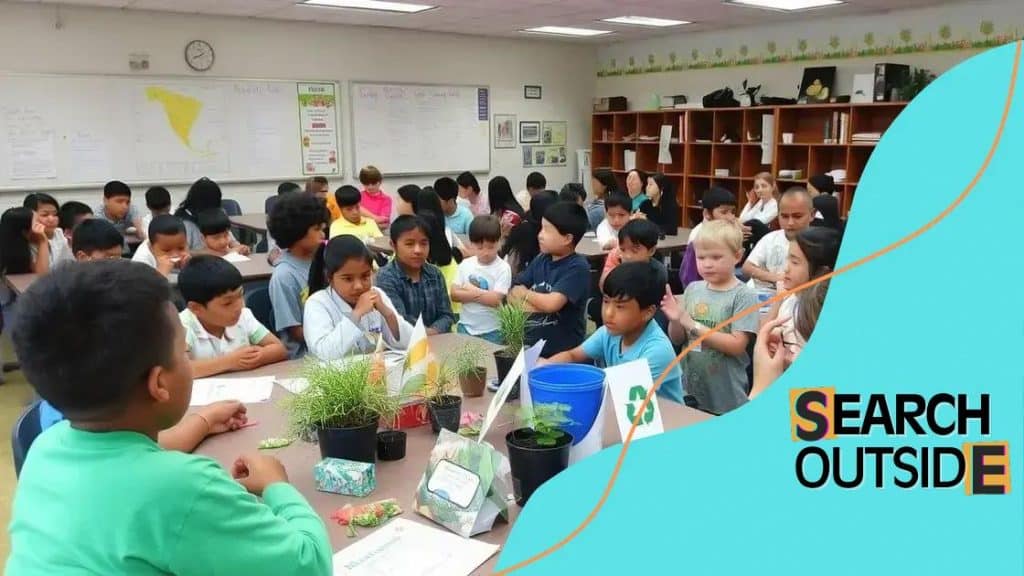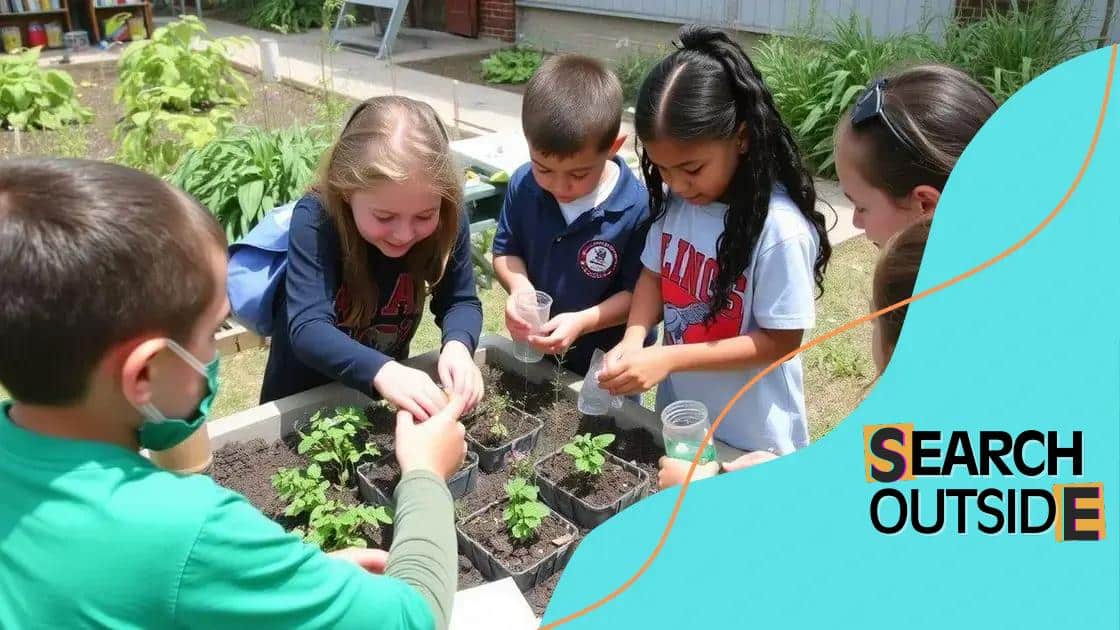How to integrate environmental education into school curricula

Integrating environmental education into school curricula involves hands-on activities, collaboration with local organizations, and effective assessments to empower students as responsible advocates for sustainability.
How to integrate environmental education into school curricula is a crucial topic today. Schools play a vital role in shaping students’ understanding of our planet’s challenges. So, how can educators weave this theme into everyday lessons?
Understanding the importance of environmental education
Understanding the importance of environmental education is crucial for fostering a generation that respects and protects our planet. Educators have a unique opportunity to instill values of sustainability and responsibility in students.
Why is Environmental Education Important?
Environmental education helps students grasp the impact of human actions on the environment. Awareness of issues such as pollution and climate change promotes critical thinking and responsible citizenship. By learning about the environment, students can connect their studies to the real world.
Key Benefits of Environmental Education
- It encourages students to develop a sense of place and community, fostering a connection to the environment.
- Students learn to think critically about ecological issues, preparing them for complex decision-making.
- Environmental education promotes personal responsibility towards the planet, encouraging sustainable practices.
Incorporating environmental education into curricula prepares students for future challenges. It equips them with knowledge and skills necessary for advocating for the environment. This subject matter is not just about memorizing facts; it’s about inspiring action and engagement.
By engaging in discussions and projects related to their local ecosystems, students can observe firsthand the effects of their actions. Field trips, nature walks, and hands-on activities make learning enjoyable while reinforcing the importance of environmental stewardship.
As climate change issues escalate, the role of education becomes even more vital. Through environmental education, students learn to ask questions, solve problems, and think creatively. This way, they become active participants in shaping a sustainable future.
Incorporating environmental themes across subjects
Incorporating environmental themes across subjects enriches the learning experience for students. This approach connects various disciplines to real-world issues, enhancing relevance.
Multi-Disciplinary Learning
When environmental education is integrated into different subjects, students can see the connections. For example, in science classes, students study ecosystems and biodiversity. In literature, they can read stories focused on nature or environmental activism.
Practical Applications
- In mathematics, students can analyze data related to environmental statistics.
- History lessons can explore environmental movements and their impact.
- Art classes can encourage students to create projects focusing on nature conservation.
Such integration makes lessons more engaging for students. When they relate math problems to calculating their carbon footprints or explore how geography affects local ecosystems, the lessons become more meaningful. Each subject contributes to a larger understanding of how human actions affect the environment.
Furthermore, by collaborating with other teachers, schools can create thematic units that immerse students in environmental topics. This type of collaboration not only enhances learning but also fosters teamwork among educators.
Field trips can serve as exciting opportunities to reinforce these themes. Visiting local habitats or conservation projects creates practical experiences that deepen students’ understanding of environmental concepts. By seeing the real-world applications, students grasp the importance of their role in protecting the planet.
Hands-on activities to engage students

Hands-on activities are essential for engaging students in environmental education. These activities bring learning to life and allow students to experience concepts directly.
Interactive Projects
Students can participate in projects like creating a school garden or starting a recycling program. These activities encourage teamwork while fostering a love for the environment. When students grow plants, they learn about ecosystems and sustainability.
Field Experiments
- Conducting water quality tests in local rivers or ponds helps students understand pollution.
- Using outdoor classrooms allows students to observe biodiversity.
- Students can collect soil samples to study composition and its effect on plant growth.
Through these interactive experiences, students can see the impact of their actions. When they focus on community conservation efforts, they understand their role in safeguarding the environment. Hands-on activities also promote critical thinking as students analyze results and reflect on their findings.
Additionally, educators can organize nature hikes where students can explore local habitats. This exploration helps them appreciate nature’s beauty and understand the importance of preserving it. As they encounter wildlife, they learn to identify species and recognize their roles in the ecosystem.
By incorporating these hands-on activities, teachers can create a vibrant learning environment. This approach not only makes lessons enjoyable but also instills lifelong values of environmental stewardship in students.
Collaboration with local environmental organizations
Collaboration with local environmental organizations can greatly enhance environmental education in schools. These partnerships bring real-world experience into the classroom, making learning more impactful.
Benefits of Collaborating
Working with local organizations allows students to participate in community projects. They can engage in activities like tree planting, clean-up drives, or wildlife conservation efforts. This hands-on experience strengthens their understanding of ecological principles while instilling a sense of responsibility.
Creating Meaningful Connections
- Students gain insights from environmental experts who can share knowledge and experiences.
- Field trips organized with organizations offer students immersive learning opportunities.
- Collaboration helps students develop soft skills like teamwork and communication.
When students see the outcomes of their efforts, they feel empowered. For instance, after planting trees, they can witness the benefits to their local environment over time. Such projects foster a strong connection to their community and the planet.
Additionally, local organizations can provide resources like educational materials, guest speakers, and volunteer opportunities. This support enriches the curricula and aligns lessons with current environmental issues. Students become informed citizens who can advocate for sustainable practices.
Through these collaborations, schools can create a network of support that encourages ongoing engagement with environmental issues. This partnership not only enhances educational outcomes but also cultivates future leaders in environmental stewardship.
Assessment strategies for environmental education
Assessment strategies for environmental education are vital for understanding how well students grasp ecological concepts. Effective assessments help educators tailor their teaching methods and improve student learning.
Types of Assessments
There are various ways to assess students’ knowledge and skills in environmental education. Formative assessments provide ongoing feedback during the learning process. For example, quizzes and group discussions can help teachers gauge understanding before moving to new topics.
Summative Assessments
- Projects that require students to apply what they have learned, like creating a sustainability plan for the school.
- Presentations on local environmental issues encourage research and communication skills.
- Portfolios that showcase students’ work over time highlight their learning journey.
These assessments not only evaluate knowledge but also motivate students. When they work on real-world problems, their learning becomes more meaningful. Students see the impact of their work, making them more invested in environmental issues.
Using rubrics can help clarify expectations. They guide students on what is required for successful projects, such as the criteria for creating an engaging presentation. Feedback from rubrics helps students understand their strengths and areas for improvement.
Moreover, incorporating self-assessments encourages students to reflect on their learning. Asking them to identify their progress and challenges can promote deeper thinking about their environmental responsibility. By involving students in the assessment process, they become active participants in their education.
Incorporating environmental education into school curricula is crucial for nurturing responsible future citizens. By integrating hands-on activities, collaborating with local organizations, and employing effective assessment strategies, educators can create a dynamic learning environment. This approach not only educates students about ecological issues but also fosters a deep connection to their communities. As students engage in these meaningful experiences, they develop critical thinking skills, a sense of responsibility, and a lifelong commitment to protecting our planet. Together, we can empower the next generation to become enthusiastic advocates for environmental sustainability.
FAQ – Frequently Asked Questions about Integrating Environmental Education into School Curricula
How can hands-on activities enhance environmental education?
Hands-on activities engage students actively, allowing them to experience concepts directly, which fosters a deeper understanding of environmental issues.
What are the benefits of collaborating with local organizations?
Collaborating with local organizations provides students with real-world experiences, resources, and insights from experts, enriching their learning.
What types of assessments can be used in environmental education?
Formative assessments like quizzes, projects, and presentations can effectively evaluate students’ knowledge and engagement with environmental topics.
How does environmental education benefit students’ futures?
Environmental education promotes critical thinking, responsibility, and advocacy skills, preparing students to become informed citizens and sustainability advocates.





